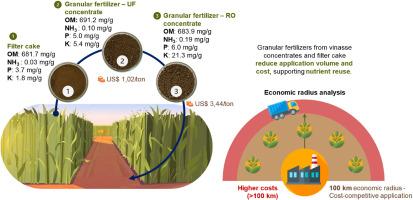Soil fertilization potential and nutrient dynamics of organic fertilizers derived from sugarcane residues under techno-economic and environmental assessment
IF 8.1
2区 环境科学与生态学
Q1 ENVIRONMENTAL SCIENCES
引用次数: 0
Abstract
This study investigates the nutrient dynamics and soil fertilization potential of organic fertilizers produced from sugarcane industry residues. Vinasse was treated through ultrafiltration (UF) and reverse osmosis (RO) to concentrate on macronutrients. The concentrates were then incorporated into filter cake during granulation, generating two types of fertilizers: (i) UF-based and (ii) RO-based formulations. Nutrient enrichment enabled a 2.9- to 11.8-fold reduction in application mass per hectare compared to raw residues. Although sodium was also concentrated, the sodium adsorption ratio remained below thresholds for wastewater reuse in agriculture (<3 meq/L). Nutrient release kinetics revealed that nitrogen was the most readily available nutrient (k = 2.52–3.61 d−1), with delayed release of potassium, phosphorus, and sodium. Column leaching tests further revealed greater retardation factors for granular fertilizers (R: 3.1–32.4) when compared with the liquid concentrates obtained from UF and RO processes, confirming reduced mobility and enhanced nutrient retention. The soil solution analyses confirmed nutrient accumulation in the upper layers (0–10 cm), indicating a low leaching risk and greater plant availability. Earthworm avoidance tests indicated no toxicity, even in RO-based fertilizers, while high filter cake doses alone trigger complete avoidance. In all scenarios analyzed, RO and UF-based fertilizers presented a lower potential for N2O and CO2 emission when compared to the commercial mineral fertilizers. Finally, economic analysis showed that the granular fertilizers are cost-competitive (fertilization costs: US$8.5–12.1/ha), especially when considering application logistics. Comparing the fertilizers, ROc-based demonstrated better nutritional performance with higher nutritional concentrations and immediate response to plant needs. UFc-based fertilizers, on the other hand, stood out for their high concentration of organic matter, with widespread use in soil improvement. Overall, the results demonstrate the technical, environmental, and economic feasibility of converting agro-industrial residues into safe and effective fertilizers. Furthermore, the work stands out in identifying pathways toward a more resilient, safe, and low-environmental-impact agriculture.

技术经济与环境评价下甘蔗残茬有机肥的土壤施肥潜力与养分动态
研究了甘蔗工业残茬有机肥的养分动态和土壤施肥潜力。采用超滤(UF)和反渗透(RO)技术对酒糟进行浓缩处理。然后在造粒期间将浓缩物掺入滤饼中,产生两种类型的肥料:(i) uf基和(ii) ro基配方。与原始残留物相比,养分富集使每公顷施用量减少2.9至11.8倍。虽然钠也被浓缩了,但钠的吸附比仍然低于农业废水回用的阈值(-1),钾、磷和钠的释放延迟。柱淋试验进一步显示,与UF和RO工艺获得的液体浓缩物相比,颗粒肥料(R: 3.1-32.4)的缓凝系数更大,证实了流动性降低和养分保留增强。土壤溶液分析证实养分在上层(0-10 cm)积累,表明淋失风险低,植物可利用性更高。蚯蚓回避试验表明,即使在ro基肥料中也没有毒性,而高滤饼剂量单独引发完全回避。在所分析的所有情景中,与商业矿物肥料相比,RO和uf基肥料的N2O和CO2排放潜力较低。最后,经济分析表明,颗粒肥料具有成本竞争力(施肥成本:8.5-12.1美元/公顷),特别是在考虑施用物流时。与其他肥料相比,roc型肥料具有更高的营养浓度和对植物需求的快速响应能力,具有更好的营养性能。另一方面,基于ufc的肥料因其高浓度的有机物而脱颖而出,在土壤改良中得到广泛应用。总体而言,结果表明将农用工业残留物转化为安全有效的肥料在技术、环境和经济上都是可行的。此外,这项工作在确定通往更有弹性、更安全、对环境影响更小的农业的途径方面也很突出。
本文章由计算机程序翻译,如有差异,请以英文原文为准。
求助全文
约1分钟内获得全文
求助全文
来源期刊

Chemosphere
环境科学-环境科学
CiteScore
15.80
自引率
8.00%
发文量
4975
审稿时长
3.4 months
期刊介绍:
Chemosphere, being an international multidisciplinary journal, is dedicated to publishing original communications and review articles on chemicals in the environment. The scope covers a wide range of topics, including the identification, quantification, behavior, fate, toxicology, treatment, and remediation of chemicals in the bio-, hydro-, litho-, and atmosphere, ensuring the broad dissemination of research in this field.
 求助内容:
求助内容: 应助结果提醒方式:
应助结果提醒方式:


